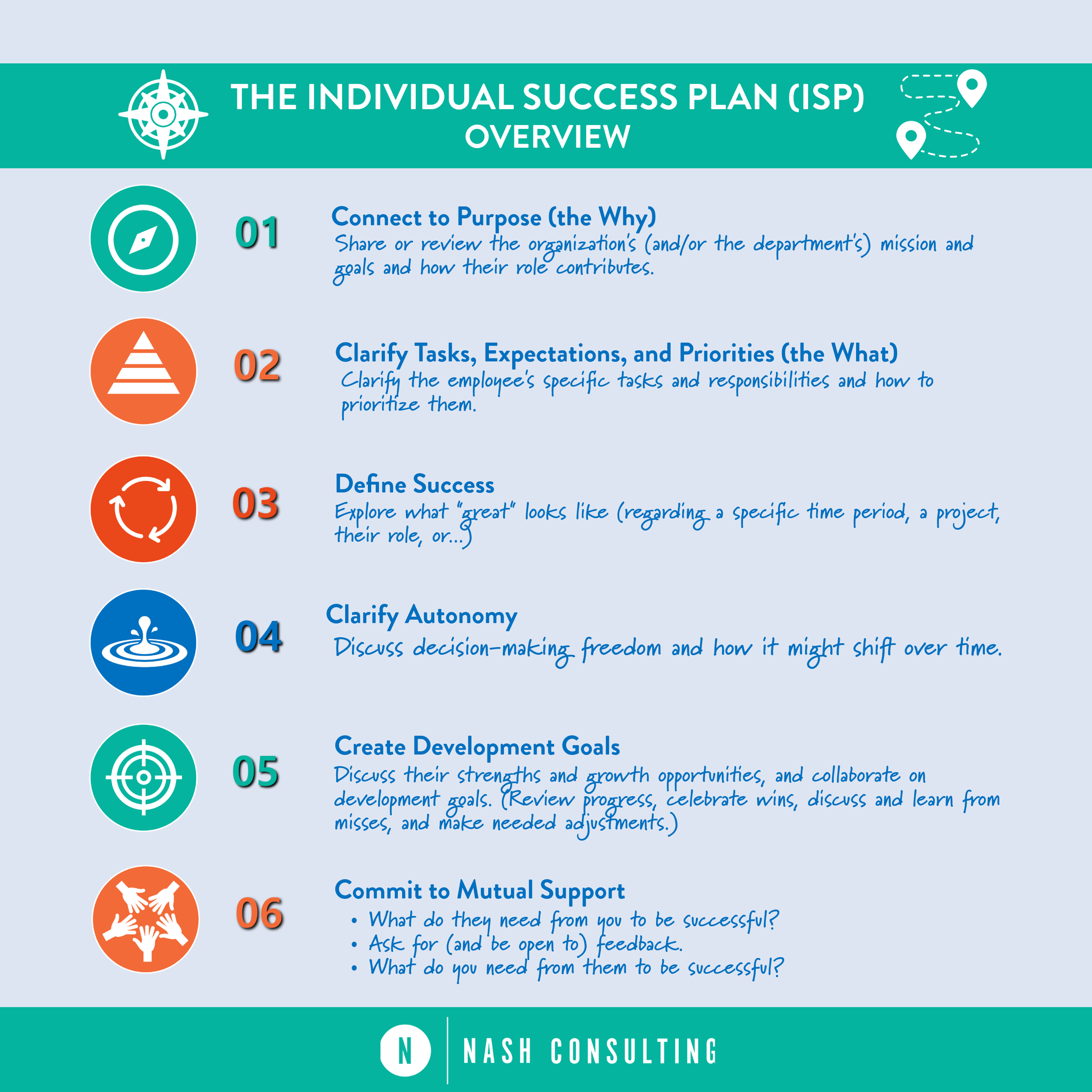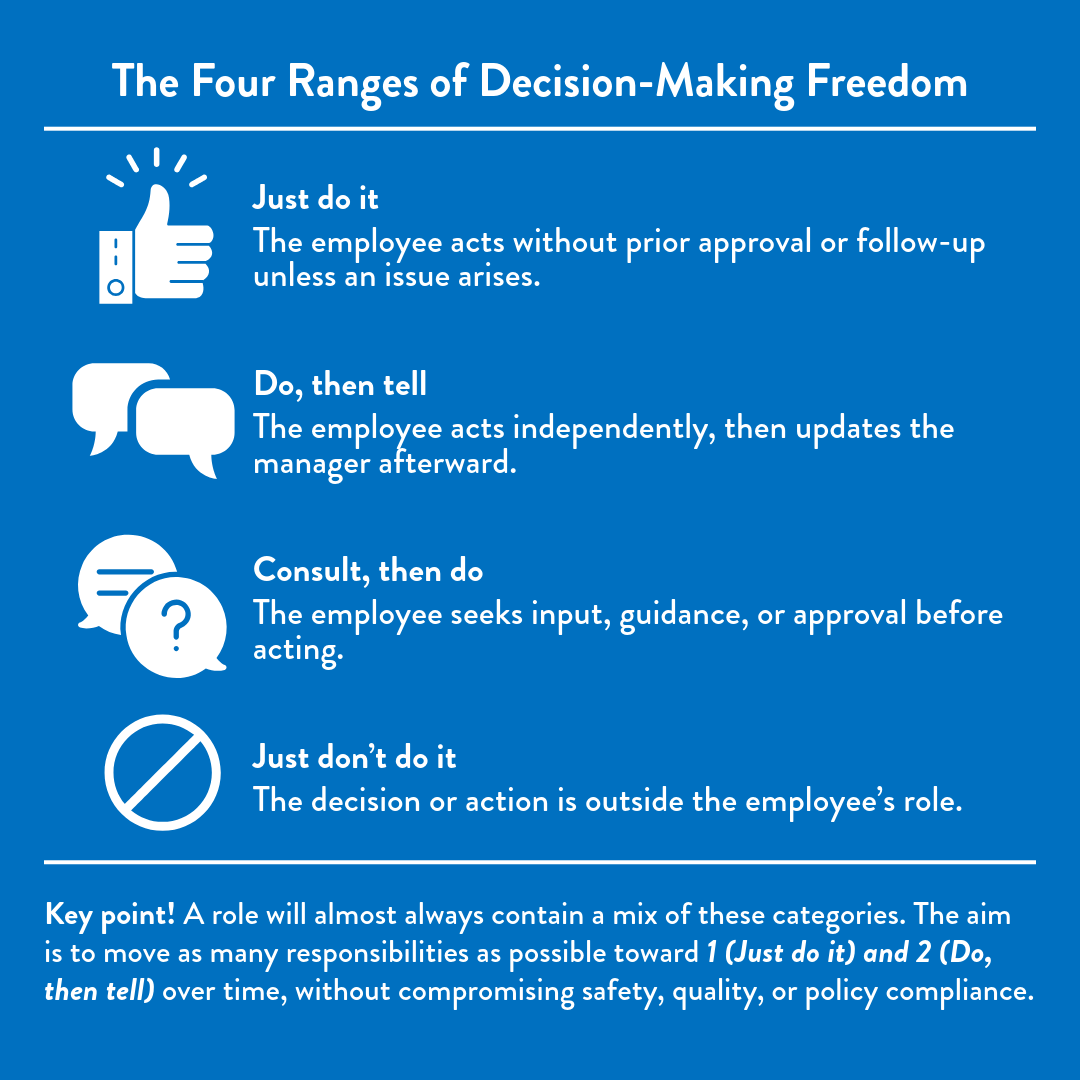The Employee-Manager Alignment Process That Works
A Practical Guide for Implementing the Individual Success Plan Process
(Including checklists and scripts for each step)
“Wait… what exactly am I supposed to be focusing on right now?”
“Wait…why is this a good use of my time?”
“Umm…I didn’t realize that this was a bigger priority.”
“But I was never told that this is a decision I could make.”
***
If you’ve managed people for more than five minutes, you’ve probably heard some version of these statements. And if you’ve been managed, you’ve probably felt this: uncertainty about expectations, shifting priorities, or how your day-to-day work actually connects to anything important to the organization.
This lack of clarity and alignment isn’t just frustrating — it’s costly. It slows teams down, saps morale, and leads to missed goals and wasted effort. That’s why alignment between managers and employees matters so much. And it’s exactly what the Individual Success Plans (ISP) process is designed to create.
Whether you’re a new manager or a seasoned leader, this article gives you everything you need to roll out ISPs with confidence: a clear overview of the process, ready-to-use checklists, and helpful scripts for each step.
The Basics
An ISP is a simple but powerful tool: A GPS for the relationship between a manager and an employee. It ensures both sides are aligned around the same two questions:
For the employee: What does success look like for me right now?
For the manager: How can I best support you in achieving that success?
When everyone on a team can answer those questions with confidence—and all point in the same strategic direction—you create clarity, accountability, and momentum at every level.
(FYI - we did a whole podcast episode talking through this process and its nuances. Check it out here.)
The ISP Overview
Guiding Principles for ISPs
Tone matters most — The conversation between managers and employees should feel collaborative, supportive, and positive; not top-down, punitive, or like a performance review or “PIP.”
Structure should enable smart autonomy — Clear goals and expectations allow freedom within defined boundaries, creating greater confidence and motivation.
Flexibility is essential — ISPs can be quarterly, monthly, or project-based, and may range from simple to highly detailed, depending on the role.
Consistency is key — Every employee should have an active ISP at all times, reviewed regularly to ensure relevance.
Cascading clarity — The ISP process starts with leaders but is meant for everyone. Senior leaders model the process, then cascade it down so every employee benefits from the same clarity and alignment.
The ISP Process - Checklists & Talking Points
These checklists and prompts for each step of the ISP are intended as a flexible framework, not a rigid script. Managers should use their judgment to adapt to the realities of the employee’s role and context. And remember: The goal of an ISP is alignment, clarity, and mutual success — not evaluation.
***
Step 1: Connect to Purpose (The Why)
Objective: Help the employee see how their work directly supports the organization’s mission, goals, and current priorities. This creates shared meaning and context for the rest of the ISP.
Checklist:
✅Review together:
Organization’s mission and goals
Department/team goals
Key initiatives
✅Explore how the employee’s role connects:
“Are our goals and initiatives clear to you? In what ways do you see your job contributing to these priorities?”
“Here’s how I see your role contributing to our success: [examples]. How does that align with your perspective?”
“This initiative is important because [reason]. Your work impacts it by [explain]. Do you see other ways your role can make a difference here?”
Step 2: Clarify Tasks, Expectations, and Priorities (The What)
Objective: Ensure the employee understands their key responsibilities, how to prioritize, and what’s expected in the current period.
Checklist:
✅Review:
Core responsibilities (ongoing duties)
Current projects/assignments
New or temporary responsibilities
✅Clarify priorities:
Which tasks/projects are most critical
What can be deferred or attended to if there is time
Highlight one learning goal for the period (to be detailed further in Step 5)
Conversation Starters:
“Let’s review your core responsibilities to make sure we’re on the same page.”
“If you had to list your top priorities this [time period], what would they be?”
“Where do you anticipate challenges in balancing these priorities, and how can I help?”
Step 3: Define Success
Objective: Create a shared understanding of what “great” looks like for the role, projects, and tasks for this period.
Checklist:
✅Identify desired outcomes for:
Ongoing responsibilities
Specific projects/tasks
✅Clarify success indicators:
Quality of work
Measurable results
Observable behaviors
Communication and updates
Set timelines and checkpoints
Conversation Starters:
“When you think about doing your best work this quarter, what would that look like?”
“Here’s what success looks like from my perspective — how does that compare with yours?”
“If challenges arise, how will we know soon enough to adjust?”
Step 4: Clarify Autonomy
Objective: Ensure the employee and manager share a clear understanding of decision-making freedom for each area of responsibility — and agree on a path to increase autonomy where possible.
Introducing the Ranges of Decision-Making Freedom!
Every job involves decisions that fall into different autonomy categories. Misalignment here is one of the most common sources of frustration and missed expectations. The goal is to be explicit so both sides know where independent action is encouraged, and where consultation or approval is required.
When considering whether to expand autonomy, weigh:
Clarity of expectations – Does the employee fully understand what success looks like?
Past performance & judgment – Have they shown they can make sound decisions in similar situations?
Risk tolerance & safety nets – What’s the impact if it’s mishandled? Is quick support available if needed?
Checklist:
✅Categorize each of the employee’s responsibilities and recurring decisions into one of the four ranges
✅Discuss the reasoning for each category — from both perspectives
✅Identify areas where autonomy can increase, and what’s needed to make that possible (skills, trust, resources, clarity)
✅Document and save the agreed-upon autonomy map for reference and follow-up
Conversation Starters:
“Let’s walk through your responsibilities and agree where each falls in terms of decision-making freedom.”
“Where would you like more independence, and what would it take for both of us to feel confident about that?”
“Here’s an area I think you could move from ‘Consult, then do’ to ‘Do, then tell’ — what do you think?”
Step 5: Create Development Goals
Objective: Identify strengths, growth opportunities, and 1–3 concrete development goals.
Checklist:
✅Discuss strengths and celebrate wins:
What they do well
Recent successes
Skills or behaviors others rely on
✅Reflect on and learn from misses.
✅Identify growth opportunities:
Skills, knowledge, or behaviors to improve performance
Areas that could increase autonomy
✅Collaborate on 1–3 goals and identify needed resources/support/training
Conversation Starters:
“Looking back at the last period, what are you most proud of?”
“Here’s something I think you did exceptionally well — how did you approach it?”
“Where do you think things didn’t go as well as you had hoped, and what did you learn from it?”
“Here’s my perspective on something that could have gone better…how does this sit with you?”
6. Commit to Mutual Support
Objective: Clarify what each person needs from the other for shared success.
Checklist:
✅Ask what the employee needs from you to be successful:
Support, resources, or tools
Coaching or guidance
Help removing barriers
✅Ask for feedback on your leadership.
✅Clarify what you need from them:
Communication habits, updates, ownership of responsibilities.
Conversation Starters:
“What do you need from me to be successful this period?”
“What’s something I’m doing — or not doing — that makes your work harder?”
“Here’s what I need from you to be successful — how does that sound?”
The Big Caveat: These Suck Without Emotional Intelligence
Processes like Individual Success Plans (ISPs) create the channels for manager-employee alignment. The problem? Many organizations stop at the process level — how to set expectations, run meetings, hold one-on-ones, or apply discipline. Organizations may rely on systems, strategies, and processes — but at their core, they are profoundly human. Even the best processes can’t outrun low morale. People need connection, respect, and care.
That’s why the most successful, resilient organizations are built not just on good management processes, but on human-centered leadership skills that form the connective tissue that honors the relational side of work.
For insights into the Emotional Intelligence toolkit that turn management processes and practices into healthy, high-performing work relationships, check out the following Nash Consulting resources:
Blog Post: Self-Compassion and a Growth Mindset
Podcast Episode: How to Really Listen
Blog Post: Listen to me!
Podcast Episode: How to Receive Feedback
Blog Post: Building Trust & Respect Through Non-Defensiveness
Blog Post: The Art & Science of Giving Feedback
***
We always like to hear from our readers. Feel free to email us at contact@nashconsulting.com if you have any questions or topics you'd like us to cover.



